Abstract
When electrical resonances were observed in acoustic sensory cells of lower vertebrates, the hearing research community was presented with the exciting possibility that tuning in the ears of those animals might be explained directly in terms of familiar molecular devices. It is reported here that in the frog sacculus, where electrical resonances have been observed in isolated hair cells, the effects of those resonances are completely obscured in the tuning properties of the sacculus in the intact ear. This observation has important implications not only for students of the ear, but for reductionist biologists in general. All of the dynamic properties of a system of connected, bidirectional processes are consequences of all of those processes at once; in such a system, the properties of an experimentally isolated subsystem may be totally obscured in the operation of the system as a whole.
Full text
PDF
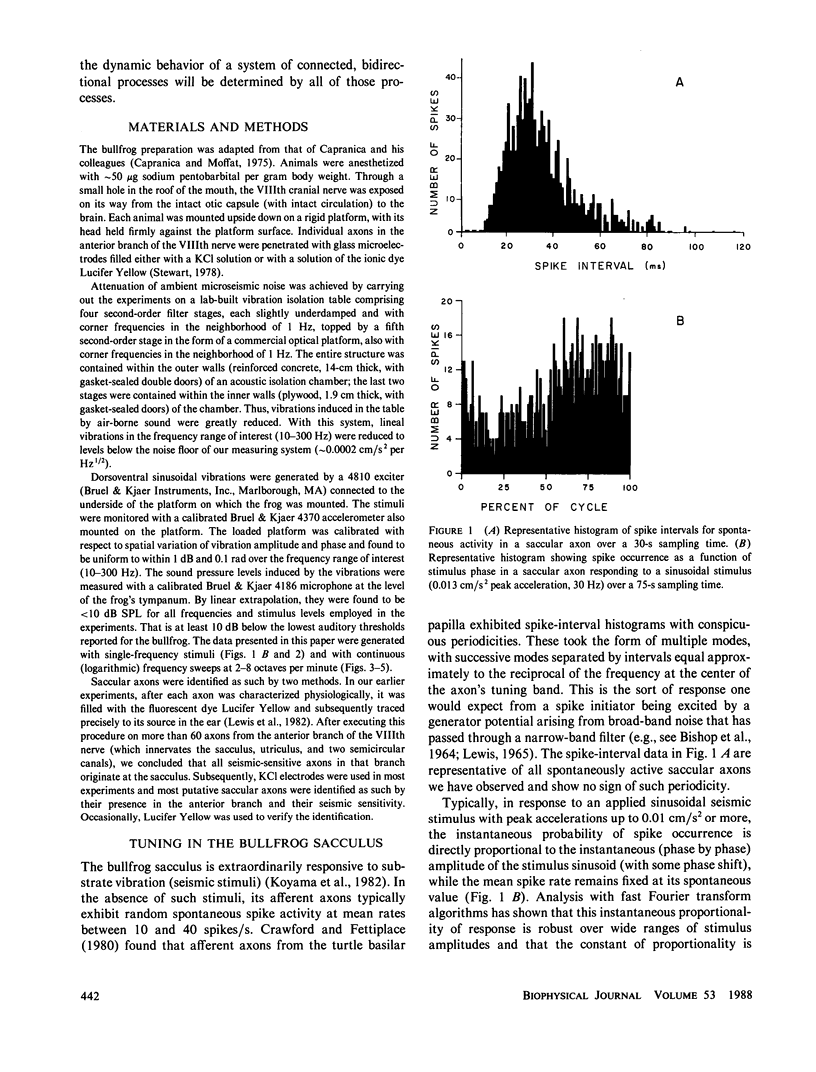
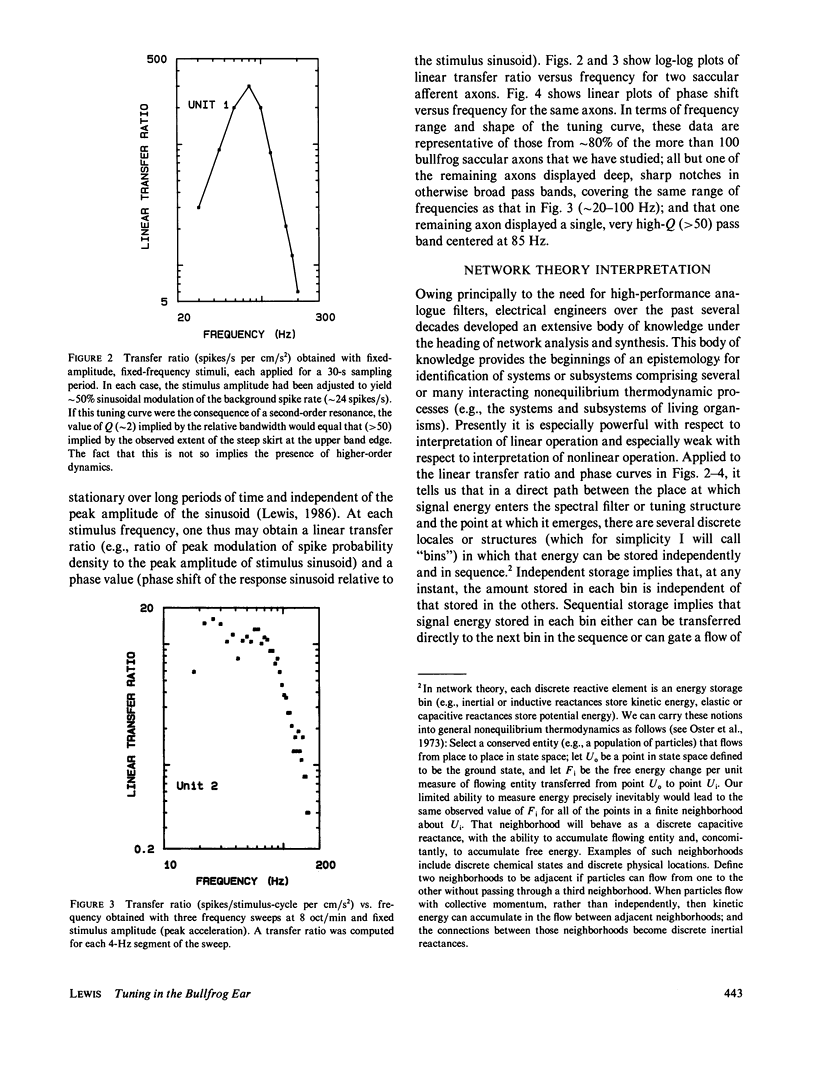
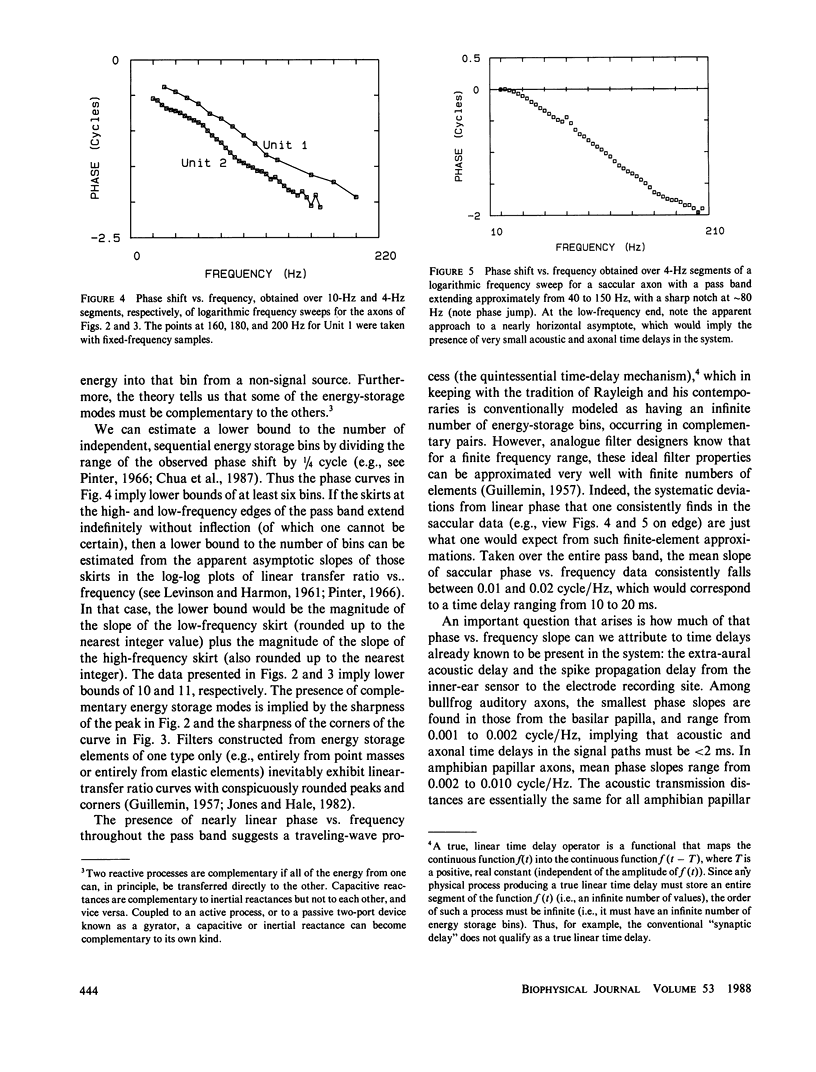
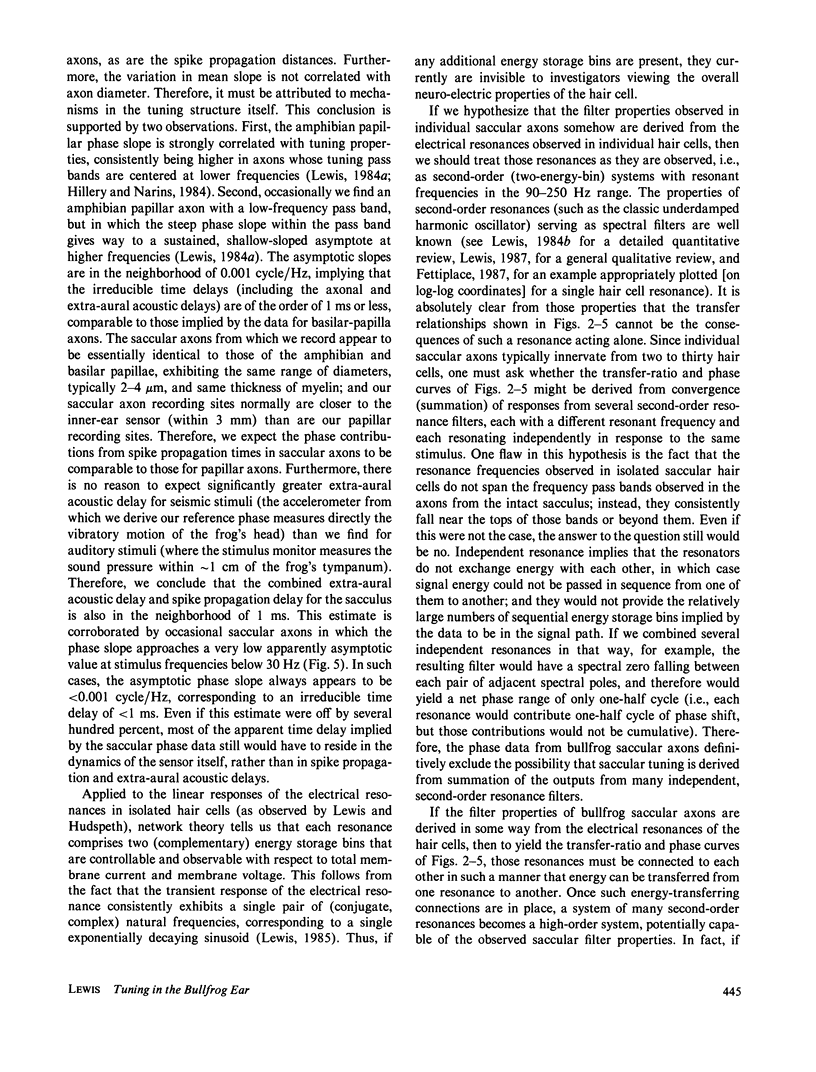
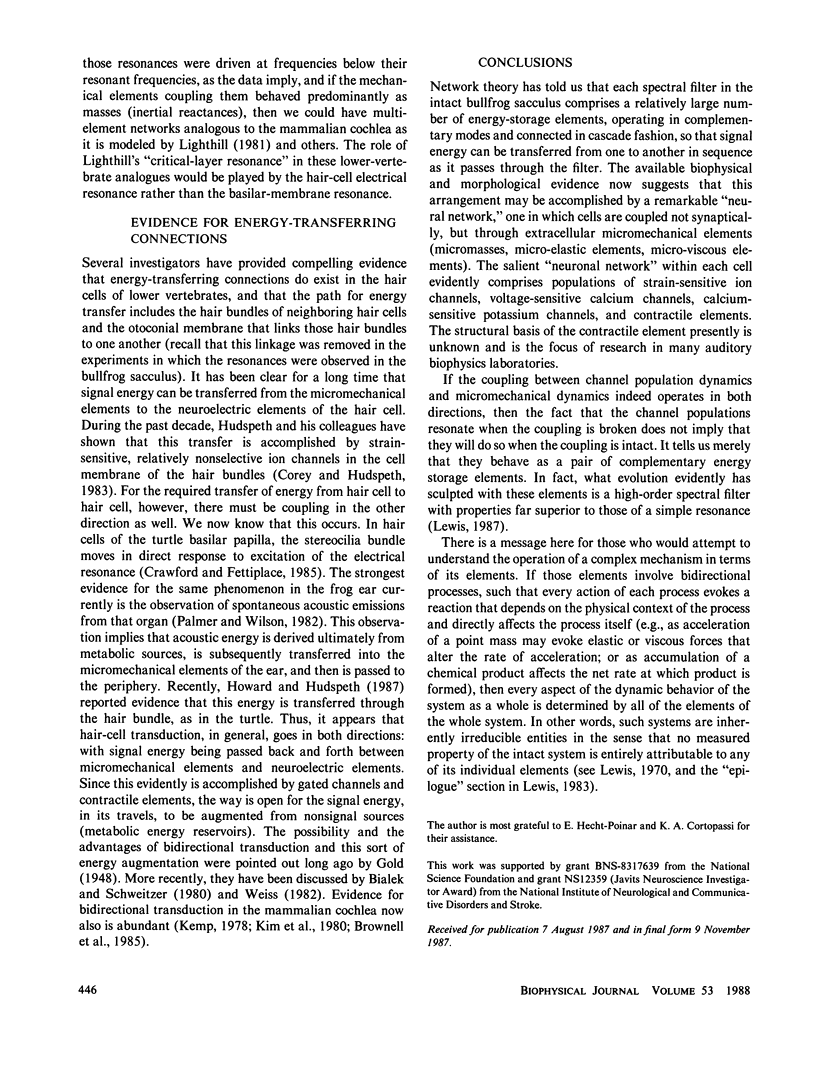
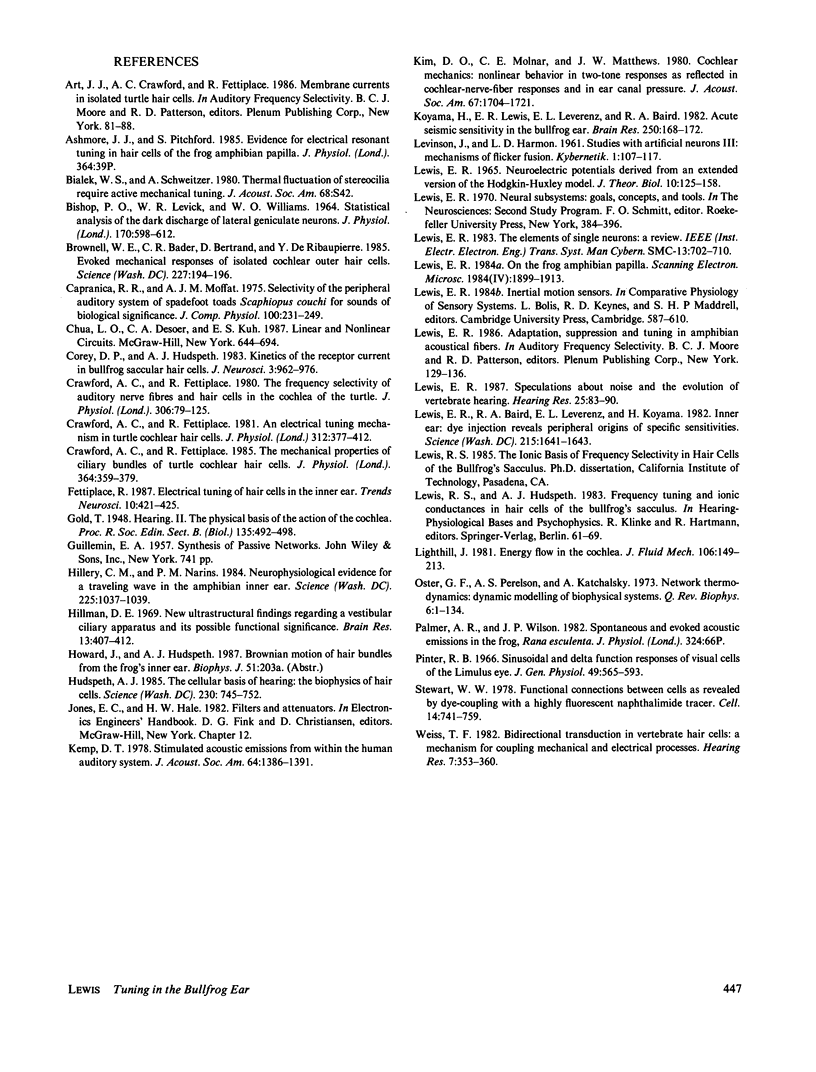
Selected References
These references are in PubMed. This may not be the complete list of references from this article.
- BISHOP P. O., LEVICK W. R., WILLIAMS W. O. STATISTICAL ANALYSIS OF THE DARK DISCHARGE OF LATERAL GENICULATE NEURONES. J Physiol. 1964 Apr;170:598–612. doi: 10.1113/jphysiol.1964.sp007352. [DOI] [PMC free article] [PubMed] [Google Scholar]
- Brownell W. E., Bader C. R., Bertrand D., de Ribaupierre Y. Evoked mechanical responses of isolated cochlear outer hair cells. Science. 1985 Jan 11;227(4683):194–196. doi: 10.1126/science.3966153. [DOI] [PubMed] [Google Scholar]
- Corey D. P., Hudspeth A. J. Kinetics of the receptor current in bullfrog saccular hair cells. J Neurosci. 1983 May;3(5):962–976. doi: 10.1523/JNEUROSCI.03-05-00962.1983. [DOI] [PMC free article] [PubMed] [Google Scholar]
- Crawford A. C., Fettiplace R. An electrical tuning mechanism in turtle cochlear hair cells. J Physiol. 1981 Mar;312:377–412. doi: 10.1113/jphysiol.1981.sp013634. [DOI] [PMC free article] [PubMed] [Google Scholar]
- Crawford A. C., Fettiplace R. The frequency selectivity of auditory nerve fibres and hair cells in the cochlea of the turtle. J Physiol. 1980 Sep;306:79–125. doi: 10.1113/jphysiol.1980.sp013387. [DOI] [PMC free article] [PubMed] [Google Scholar]
- Crawford A. C., Fettiplace R. The mechanical properties of ciliary bundles of turtle cochlear hair cells. J Physiol. 1985 Jul;364:359–379. doi: 10.1113/jphysiol.1985.sp015750. [DOI] [PMC free article] [PubMed] [Google Scholar]
- Hillery C. M., Narins P. M. Neurophysiological evidence for a traveling wave in the amphibian inner ear. Science. 1984 Sep 7;225(4666):1037–1039. doi: 10.1126/science.6474164. [DOI] [PubMed] [Google Scholar]
- Hillman D. E. New ultrastructural findings regarding a vestibular ciliary apparatus and its possible functional significance. Brain Res. 1969 Apr;13(2):407–412. doi: 10.1016/0006-8993(69)90301-1. [DOI] [PubMed] [Google Scholar]
- Hudspeth A. J. The cellular basis of hearing: the biophysics of hair cells. Science. 1985 Nov 15;230(4727):745–752. doi: 10.1126/science.2414845. [DOI] [PubMed] [Google Scholar]
- Kemp D. T. Stimulated acoustic emissions from within the human auditory system. J Acoust Soc Am. 1978 Nov;64(5):1386–1391. doi: 10.1121/1.382104. [DOI] [PubMed] [Google Scholar]
- Kim D. O., Molnar C. E., Matthews J. W. Cochlear mechanics: nonlinear behavior in two-tone responses as reflected in cochlear-nerve-fiber responses and in ear-canal sound pressure. J Acoust Soc Am. 1980 May;67(5):1704–1721. doi: 10.1121/1.384297. [DOI] [PubMed] [Google Scholar]
- Koyama H., Lewis E. R., Leverenz E. L., Baird R. A. Acute seismic sensitivity in the bullfrog ear. Brain Res. 1982 Oct 28;250(1):168–172. doi: 10.1016/0006-8993(82)90964-7. [DOI] [PubMed] [Google Scholar]
- LEVINSON J., HARMON L. D. Studies with artificial neurons. III. Mechanisms of flicker-fusion. Kybernetik. 1961 Dec;1:107–117. doi: 10.1007/BF00290181. [DOI] [PubMed] [Google Scholar]
- Lewis E. R., Baird R. A., Leverenz E. L., Koyama H. Inner ear: dye injection reveals peripheral origins of specific sensitivities. Science. 1982 Mar 26;215(4540):1641–1643. doi: 10.1126/science.6978525. [DOI] [PubMed] [Google Scholar]
- Lewis E. R. Neuroelectric potentials derived from an extended version of Hodgkin-Huxley model. J Theor Biol. 1966 Jan;10(1):125–158. doi: 10.1016/0022-5193(66)90181-0. [DOI] [PubMed] [Google Scholar]
- Lewis E. R. Speculations about noise and the evolution of vertebrate hearing. Hear Res. 1987;25(1):83–90. doi: 10.1016/0378-5955(87)90082-7. [DOI] [PubMed] [Google Scholar]
- Oster G. F., Perelson A. S., Katchalsky A. Network thermodynamics: dynamic modelling of biophysical systems. Q Rev Biophys. 1973 Feb;6(1):1–134. doi: 10.1017/s0033583500000081. [DOI] [PubMed] [Google Scholar]
- Pinter R. B. Sinusoidal and delta function responses of visual cells of the Limulus eye. J Gen Physiol. 1966 Jan;49(3):565–593. doi: 10.1085/jgp.49.3.565. [DOI] [PMC free article] [PubMed] [Google Scholar]
- Stewart W. W. Functional connections between cells as revealed by dye-coupling with a highly fluorescent naphthalimide tracer. Cell. 1978 Jul;14(3):741–759. doi: 10.1016/0092-8674(78)90256-8. [DOI] [PubMed] [Google Scholar]
- Weiss T. F. Bidirectional transduction in vertebrate hair cells: a mechanism for coupling mechanical and electrical processes. Hear Res. 1982 Aug;7(3):353–360. doi: 10.1016/0378-5955(82)90045-4. [DOI] [PubMed] [Google Scholar]


